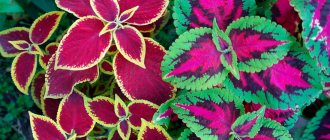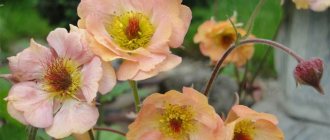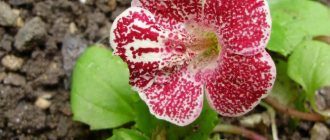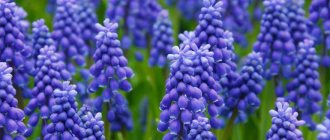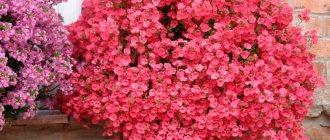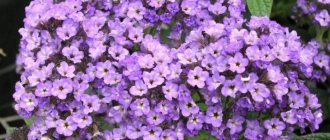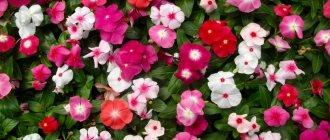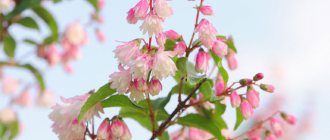In recent years, a beautiful plant, Brugmansia, has become popular. This is an original terrace flower that can be transplanted into open ground in summer. Its funnel-shaped flowers reach a length of 30 cm and smell wonderful. In summer, during one flowering period, it can produce several dozen flowers. In this article we will tell you how to grow Brugmansia - planting and care in the open ground and at home, how to ensure wintering, spring awakening, and provide a description of the varieties with photos.
Description of the plant
Novice gardeners sometimes confuse Brugmansia with Datura (Datura). Brugmansia was isolated from the Datura genus. Therefore, it’s worth first understanding the similarities and differences between Brugmansia and Datura. Datura (lat. Datura) and Brugmansia belong to the Solanaceae family.
Do not allow children to play with them, because in all species of Brugmansia and Datura, all parts of the plants are very poisonous. Consuming a few Datura seeds can result in death.
Datura is an annual herbaceous plant 0.5-1 m high, rarely tree-like. The stem is bare and erect. The leaves are dark green (the leaf blade is lighter at the bottom), alternate, reach a length of 10-15 cm, located on long petioles, ovate, with a pointed tip, light veins. Datura flowers are large, white, shaped like a funnel, the flower calyx is five-toothed. The fruit is a four-leaf capsule with thorns.
The genus Brugmansia includes trees (1.5-6 meters high, depending on the species) and subshrubs. The plant originates from South America, more precisely from the Andes regions stretching from Colombia to northern Chile and southeastern Brazil. Introduced and spread to Africa, Asia and Australia. Their popularity is due to flowers of unusual size, in the form of giant bells or so-called “tubes”. Hence the common name of Brugmansia – “angel’s trumpets”. There are hundreds of varieties in cultivation in various palettes of white, cream, yellow, orange, pink, purple and red, with single, double and even triple and quadruple flowers. The leaves and flowers are large.
Brugmansias are evergreens. When grown in temperate climates, their vegetation is largely suppressed in winter. This does not greatly affect viability as long as there are no sub-zero temperatures.
Properties of Brugmansia
Where Brugmansia comes from, the local population widely uses it as a medicinal plant. It has hallucinogenic properties that are used for religious rituals. Remember that each part of the plant contains a strong poison, or rather, they contain atropine and scopolamine in high concentrations. The flowers of this plant have a pungent odor, which can cause severe headaches.
BRUGMANSIA//My many years of experience in propagation by cuttings, planting, transplanting and preserving in winter.
Popular types and varieties - photos and descriptions
The genus Brugmansia includes 11 species. The most common types:
- Datura (lat. Brugmansia candida synonym Datura candida) (eng. Tree Datura) is also called Datura wood, angel trumpets, datura tree or snow-white Brugmansia. It is an annual plant, probably native to Central America. At low temperatures, the above-ground part freezes out and grows back in the spring. In Russia it is usually grown in pots and containers. Brugmansia is grown in open ground in the southern regions. The datura is decorated with strong-smelling cup-shaped flowers.
- Datura stramonium is a herbaceous plant of the nightshade family, growing in wastelands and landfills. Other names are stupid grass, stupefying grass, crazy grass, badura, thistle. Wild perennials grow up to 100 cm in height. The flower is large, cup-shaped, reaches a length of 10 cm, and ends with triangular petals. Flowers “look” up and to the sides and emit an unpleasant odor. The flowers appear on a widely branched stem and bloom throughout the summer, usually until the end of September. Green leaves are about 30 cm long, the leaf blades are pointed and jagged along the edges. Fruits from August to October.
- Brugmansia arborea is becoming increasingly popular. This is a perennial belonging to the Solanaceae family. It is distinguished by fragrant, funnel-shaped flowers hanging down. The flower can reach 30-45 cm in length and looks impressive against the background of dark green, 25 cm leaves. Due to its similarity to annual daturas, Brugmansia was originally classified as a Datura species.
- Golden Brugmansia (Brugmansia aurea) is a species suitable for decorating large spaces - terraces or gardens. A funnel-shaped flower with a golden color adorns the bush. The species Brugmansia aurea is a vigorous grower, which should be taken into account when choosing; in natural conditions it reaches 5 meters. The stems are tough, erect, initially green, eventually becoming woody. The leaves are large, soft, toothed, mossy, green or gray-green. The first buds are formed when the shoots are 100 cm long. The flowers are large - from 14 to 50 cm in length, overhanging (which distinguishes brugmasje from their relatives datur). Cold resistance is not bad, the species can withstand temporary temperature drops to -1, -2 ° C, Some breeding varieties do not tolerate temperatures below +5 °C.
- Brugmansia bloody (red) (Brugmansia sanguinea) - also characterized by fast, lush growth. At home, it reaches a height of 150 cm. The decoration of the species is odorless orange-red flowers reaching a length of 20 cm. Each flower has golden-yellow veins. Flowering occurs in winter - January-March, so this species can delight with its beauty in home greenhouses.
- Fragrant Brugmansia (fragrant) (Brugmansia suaveolens) - can reach a height of 3-5 m. The species is distinguished by its magnificently fragrant flowers, cream, hot pink, yellow, and white in color. The sweet scent of the flowers is strongest in August.
Brugmansias are charming flowers that can be grown in balcony boxes, large pots, or transplanted into open ground in the warm season. Majestic plants are suitable for balconies and terraces. Shrubs growing in pots, showered with bright flowers, look gorgeous. Showy potted plants often produce a pleasant aroma, further enhancing summer fun. A cut flower is suitable for decorating an apartment.
South American Brugmansia shrubs reach 4 m in height in nature, woody species can eventually grow to 10-12 m. Brugmansia in a pot, grown at home, grows up to 2 m. A variety of species, varieties and interspecific hybrids are available for sale, flowering throughout the summer, until the first frost.
There are many hybrid varieties available with white, pink, yellow, red, orange or salmon flowers.
Some varieties of Brugmansia have double flowers:
- "Angels Summertime" Angels Sumerttime;
- Angels Innovation;
- "Angels Suprise" Angels Suprise;
- Angels Sunexplosion;
- "Rosa Zauber" Rosa Zauber;
- "Susie Underhill" Susie Underhill;
- "Summedaft" Sommerduft;
- "Miss October" Miss October;
- "Barcarole" Barcarole;
- "Bolero" Bolero;
- "Bridesmaid" Bridesmaid;
- "Fandango" Fandango;
- "Edna" Edna.
Varieties with colored leaves are also decorative:
- "Maya" Maya;
- "Snowbank" Snowbank;
- "Sublime" Sublime;
- "Sunset" Sunset.
History of appearance
In ancient times, this plant attracted shamans and magicians to prepare tinctures and potions, which, in their opinion, had magical properties. Initially, Brugmansia belonged to the Datura genus; these potions and tinctures had an effect on the human body. It is not known for certain which particular variety of Brugmansia was discovered first.
Brugmansia - "angel's trumpets"
South America is considered the birthplace of the shrub. The Brugmansia flower was first mentioned by Branedba Kobo in the 50s of the 17th century. A description of the tree-like Brugmansia was mentioned by Louis Felluld in 1714. It received its current name at the beginning of the 18th century in honor of history teacher Sebald Brugmans.
Landing
Seeds and seedlings of attractive Brugmansia species are available for sale. After purchasing a seedling about 30 cm high, it is transplanted into a large pot.
What kind of pot is needed for Brugmansia:
- a seedling about 30 cm high is transplanted into a 10-liter pot;
- large seedling – volume 40 liters.
Suitable soil for planting Brugmansia is humus soil with a pH of 6-7.5.
Brugmansia, grown in open ground, prefers soils:
- fertile;
- well drained (with the addition of sand);
- preferably slightly acidic or neutral.
When placing Brugmansia on the balcony, it is worth remembering that on a small balcony, majestic plants may have too little space for free development.
Reproduction methods
Botanical varieties of Brugmansia can be propagated by cuttings or sowing seeds. Selected varieties can only be propagated by cuttings.
Cuttings
You can propagate Brugmansia yourself by cutting cuttings.
How to root Brugmansia cuttings:
- Cut fragments of the shoot apex 20 cm long, with three apical leaves, paying attention to the fact that the seedlings have a slightly woody base.
- The bases of the cuttings are immersed in a rooting agent.
- They are then placed in a damp mixture of sand and peat or water.
- The container is covered with colorless perforated film.
- Place them in a bright but not sunny place at room temperature. After 3-4 weeks, the first roots should appear.
The procedure can be carried out from spring to autumn. After a month, the rooted cuttings are transplanted into a pot filled with fertile humus substrate. After the cuttings reach about 30 cm in height, it is worth trimming the top so that the plant bushes beautifully.
Seeds
Brugmansia is sown from seeds in early spring - from January to March.
Seedlings may begin to bloom in the second year. The germination efficiency of seeds is 70-80% - it is important to prepare them correctly to increase the likelihood of obtaining healthy, strong seedlings.
Seed preparation
Preparing seeds for sowing takes place in 3 stages:
- Treatment for diseases. Disinfection of seeds with fungicides.
- Soaking - to speed up germination, seeds are immersed in warm water for 24-48 hours.
- Scarification of seeds - with a sharp instrument, such as a razor blade, the outer layer of the seed coat is damaged, which facilitates germination.
Preparing the soil for sowing
Ready-made soil mixtures available at garden centers can be used to sow seeds. Brugmansia prefers permeable, light soils, so it is worth adding sand or perlite to the finished mixture. The quality of the soil can be improved by adding humus and compost. The substrate blank can be disinfected in the oven to disinfect it.
Brugmansia seeds germinate better when they are provided with greenhouse conditions - high temperature and humidity. Therefore, the container intended for sowing must be covered, for example, with a glass lid or film, transparent plexiglass. You can poke a few small holes in the lid of the container or ventilate it regularly to avoid excessive condensation.
Sowing seeds
- Add some drainage and fertile soil to the bottom of the pot. There should be drainage holes at the bottom.
- The prepared substrate is slightly moistened.
- Carefully spread the seeds over the surface of the soil after 3 cm and press lightly. The seeds are covered with a small layer of substrate about 5 cm.
- Place the container on a windowsill or other warm, bright place in the apartment, where the minimum temperature is 22-25 degrees C.
- The container should be ventilated several times a day by opening the lid. If condensed water vapor accumulates on the surface of the lid, remove it with a paper towel.
- We check the soil moisture level daily and moisten the surface if necessary.
Growing seedlings
- The first shoots should appear within 2 weeks, but germination may take longer. We water the seedlings.
- When the seedlings have about 5-6 true leaves, they are transplanted into separate pots with fertile, well-drained soil.
- 2 weeks after transplanting into separate pots, you can begin to feed the seedlings with small doses of fertilizer.
- Young seedlings can be planted outside in the second half of May, when the danger of frost has passed. Before planting, seedlings need to be hardened off daily for 2 weeks and taken outside, exposed to the sun for an increasingly longer period of time.
Preparing the soil for replanting
For replanting, it is recommended to prepare a nutritious and light soil layer, which must include:
- lowland peat;
- humus;
- garden soil.
If necessary, it is permissible to add a small amount of vermiculite, perlite and sand to the ground. To prevent the development of fungal infections, it is recommended to mix the soil with charcoal.
Since the plant grows quite quickly, the container should be large in volume. The procedure must be carried out in early spring, before the growth points awaken. Small shrubs need to be transplanted using the transshipment method into large containers.
Growing and care
Brugmansia is thermophilic, it can be grown in the ground in the garden and in a pot on the terrace or balcony. The plant is formed in the form of a large bush or small tree. Growing Brugmansia, although labor-intensive, is very rewarding; plants can reach a height of almost 3 m, each producing hundreds of flowers per season!
Selecting a location
Due to their large size, it is important to provide the plants with a suitable location where they will show off their qualities most beautifully.
At home, Brugmansia grows best in a secluded, sunny place. In shaded positions, the bush may not develop properly and may stop blooming. At noon, when the sun is brightest, it is worth slightly shading the plant to prevent leaf burns.
In the garden, Brugmansias do not like windy positions; strong winds can destroy delicate leaves and flowers, and even knock over a huge bush growing in a pot. The species prefers semi-shaded positions, preferably in an eastern exposure or under tree branches.
Watering, fertilizing
Brugmansia requires a constantly moist substrate. In hot weather, water it more often to keep the flowers and leaves in good condition. Standing in full, hot summer sun can be uncomfortable for the plant. In such conditions, it is necessary to water 2-3 times a day; the plant consumes a huge amount of water due to its large leaves.
In mid-summer, the best growing location is in sheltered partial shade.
In order for the plant to bloom until autumn, it requires careful care. Very rapid growth and the production of a large number of large flowers requires the application of fertilizers, without which good results cannot be expected. Brugmansias require fertilizer on a regular basis - every week, along with watering, they are fertilized with multicomponent compounds, but in a slightly lower concentration than recommended on the packaging. A suitable fertilizer should contain:
- 15-17% nitrogen;
- 30% potassium;
- 10% phosphorus,
- magnesium and trace elements.
The plant develops well after applying Azofoska fertilizer. Apply 1 teaspoon of fertilizer per 5-6 quart pot.
You can also feed with plant infusions. Systematic fertilizers combined with regular watering will allow the plant to develop many flower buds. Stop feeding Brugmansia in September.
How to trim
Brugmansia needs to be trimmed properly. Flowers will appear on the upper shoots. The better the plant bushes, the more buds it has. A sign that flowers will appear on this shoot is the presence of asymmetrical leaves. Removing this year's growth that grows on the main stem or at its base also stimulates flowering.
Brugmansia is pruned before winter. Only the tender tops are cut off, and in the spring they are shortened further. For a biennial plant, we leave 2 thick shoots.
If Brugmansia is young, you should wait until it grows and only then remove the top. We also consistently remove all sprouts growing on the main shoot.
In subsequent years, we leave 3-4 branches about 1 m long). The plant may also have a single shoot that branches at the top. However, such a tree is not very stable and when grown in a pot it easily turns over. It is better to bury such a specimen in the garden with a container in the summer or plant the plant in the ground. The shoots on the trunk should be removed.
Advice. By removing faded flowers, Brugmansia will bloom more abundantly.
Overwintering a houseplant
Before the first frost, we move cold-sensitive Brugmansia indoors, for example, to a bright veranda or loggia. Plants tolerate wintering at temperatures of 5-10 degrees Celsius. Water less often in winter, be careful with moderately moist substrates - avoid over-moistening. Plants can overwinter at home - in a bright, cool room.
Wintering a plant dug from open ground
If Brugmansia is grown in open ground, in the Moscow region, in the middle zone, for the winter it is dug up and planted in large containers, for example, in a bucket. The plant produces thick tuberous roots that can be stored like dahlia tubers. Since the roots of the plant spread widely, you can transplant it into a wide basin. In this case, the above-ground part is cut off at a height of 20 cm. Stored in a cool room, with a temperature of about 10 ° C, with access to light, watering occasionally.
If it is not possible to provide a bright room, Brugmansia can overwinter in a dark cellar if it is dry and draft-free. After such storage, the plant usually does not begin to bloom longer.
Growing problems, diseases, pests
- A strong wind can break branches and throw the pot over; you need to choose a windless place.
- Heavy rain damages the leaves (it is safer to place the plant under a light roof).
- The most common growing mistakes that lead to yellowing and falling leaves are too much sunlight, lack of nutrients and water.
- The presence of pests on the undersides of leaves is also the cause of massive leaf fall. Spider mites and thrips can harm Brugmansia (their presence is indicated by small spots and cobwebs on yellowed leaves). Also, aphids and whiteflies greatly weaken plants. We destroy them with insecticides (for example, Aktara). When spraying chemicals in confined spaces, be especially careful, do not live there for the period of time indicated on the product packaging, and use personal protective equipment when working.
Transplantation without the risk of injury. Step-by-step instruction
Brugmansia (planting and care at home will help flower breeders to properly transplant the plant without the risk of injury) tolerates the transplantation procedure normally if all actions are careful and correct.
Step-by-step instructions on how to replant a plant:
- The base of the container needs to be covered with a small amount of pebbles, charcoal and expanded clay. Next you will need to add a small amount of substrate.
- The plant along with the earthen ball must be transferred to a container. If voids appear, they will need to be filled with nutritious soil mixture.
- Finally, the soil must be compacted and moistened.
During the replanting process, it is permissible to slightly shorten the roots of the flower, cutting off rotting or dying parts.
Care by month
February
In February, the plant needs to be “awakened” - moved closer to the light, and started to water moderately. It is worth replanting Brugmansia in fresh fertile humus soil, preferably with an almost neutral pH (6-7.5), shortening the shoots and, if necessary, overgrown, very thickened roots.
If there is not enough space, cut last year's shoots short (to a length of 20-30 cm).
April-March
In March, the plants “come to life”. When they begin to grow, you can start fertilizing with fertilizer for plants with decorative leaves (it contains a lot of nitrogen). Brugmansia can be planted in the ground when the threat of frost has passed.
May
At the beginning of May, the plants are gradually hardened off on the street (balcony) for at least a week. In the second half of the month they are left outdoors. If unexpected frosts are expected, the plants must be covered or brought indoors.
June July
For specimens several years old, a 20-40 liter container with large holes in the bottom is required. It is worth loading the pots with stones so that they are stable, and placing them on stands (the water will not drain too quickly, but it will not remain in excess for too long).
You can bury the pot in the ground to the middle of the height (the roots will grow through the drainage holes) in a place that has been previously fertilized with garden compost or manure. You can also plant the plant in the ground without a container.
During the season, young plants reach a length of more than a meter (in the photo there is a plant on the balcony).
Water the plants deeply, several times a day in hot weather. Otherwise, they will quickly fade and the flower buds will fall off. From May to mid-August, every 4 days we use a multi-component fertilizer for flowering plants, containing a lot of potassium and phosphorus (starvation causes yellowing and falling leaves).
In June-August, trim the tips of the shoots by 15-20 cm so that they have a slightly woody lower part. We prepare cuttings from them.
September
From the beginning of the month, we completely stop feeding and greatly limit watering.
October
Without waiting for frost to be announced, we dig up plants growing in the ground and trim the ends of the roots and branches. We plant it in a container and sprinkle it with peat or place it in a box covered with jute. Plants (including those from balconies and terraces) are transferred to cool rooms.
November
If potted specimens are moved (without pruning) to the veranda, they will bloom for a short time. Bushes do not require intensive watering. You can chop them up a little and put them in the pantry.
